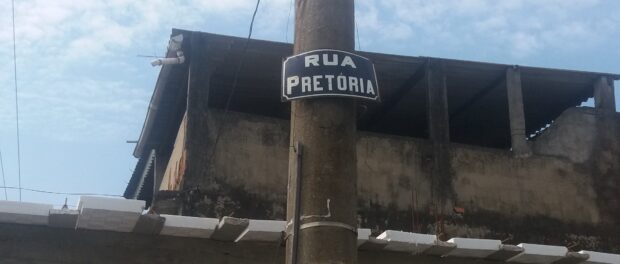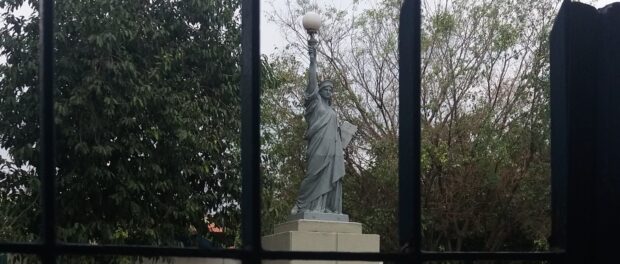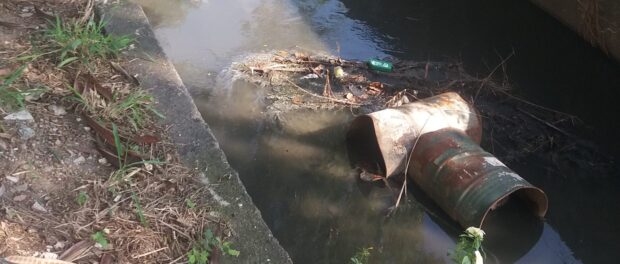
Nominated for the ‘Making a Difference’ Award in the RIO category by the O Globo newspaper, Alex Belchior is a resident of Vila Kennedy, in the West Zone, and currently works as a tour guide and researcher for the soccer museum, Museu da Pelada. His incessant curiosity and talent for historical research allowed him to trace his degree of kinship to former President João Goulart and singer Belchior, but he is best known in the community for his work leading the Vila Kennedy Portal and as an informal community historian. RioOnWatch interviewed Alex Belchior to delve deeper into the history of the community and to discover, from this history, its prospects for the future.
RioOnWatch: When did you arrive at Vila Kennedy?
Belchior: I’ve lived in the community since 1973, when I was born. I spent nine years elsewhere, but I came back.
RioOnWatch: How did your documentation work begin?
Belchior: I work on community documentation and history. I began historical research on monuments. When I returned to Rio, I took a tour guide course and chose the Vila Kennedy Statue of Liberty as the topic of my final project. Then monuments became a passion of mine. I created a technical file for each work of art all around Rio de Janeiro. I went by foot to 66 neighborhoods. It was the most enjoyable thing I’ve ever done.
From these wanderings, I assembled a project with satellite images from the Pereira Passos Institute (IPP) of all the communities and a short historical text written by residents. In 2007 I created VilaKennedy.com, Vila Kennedy’s first portal. Now I’m thinking of turning the site into a center of memory for Vila Kennedy.
RioOnWatch: Are you talking about Fala Vila Kennedy (Speak, Vila Kennedy)?
Belchior: No, Fala Vila Kennedy was born in 2013 and only has stories on Vila Kennedy, all written by me. I took the Favelas’ News Agency’s (ANF) first Community Journalism Course and then I started teaching others and other pages appeared on social networks. The idea was to foster local journalism, with print editions.
RioOnWatch: And how does this local journalism relate to the hegemonic media?
Belchior: High circulation newspapers serve as sources for this historical research and documentation, since for a long time they were the only ones that existed. In 2013 I began to research O Globo’s newspaper archives on Vila Kennedy. I also researched Jornal do Brasil and Extra. In O Globo alone there must be more than 400 articles talking about Vila Kennedy, from its history to violence and the residents’ struggle. Vila Kennedy received more media attention in the beginning, because in 1964 the community was the apple of the governor’s eyes.
RioOnWatch: Why was Vila Kennedy the apple of the governor’s eyes?
Belchior: Because Vila Kennedy emerged as a product of the State in 1964, an idea of Governor Carlos Lacerda himself. The lands had been owned by the National Institute for Colonization and Land Reform (INCRA), by the Bangu fabric factory, and had been farms. Then a housing complex of approximately 5,000 houses appears, all the same, which, in fact, reflects the government’s neglect because even the locks were the same and one key opened all the others. Vila Aliança¹ was founded in 1963, Vila Kennedy was founded in 1964 as Vila Esperança. Then [American president John] Kennedy dies and Carlos Lacerda decides to honor the former president. It was a highly publicized project, which many heads of state wanted to visit when they came to Brazil.
The first head of state to visit was the president of Senegal. And he was fascinated that the community’s streets had names of African countries. But there was no street called Senegal, so Lacerda ordered Burundi Street to be changed to Senegal. I, for example, live on Zambia Street. The king of Belgium was also here in 1965. On that occasion a lady began to sing the Belgian anthem in French, because she had been raised in the home of a Belgian diplomat’s family.
RioOnWatch: Does the Statue of Liberty at the entrance to the community have to do with those visits?
Belchior: It came from France, Brazilian emperor Dom Pedro II visited the sculptor at the time. The book the statue holds in her arm does not reflect the independence of either France or the United States, but the proclamation of the Republic of Brazil. It was brought from overseas by the Baron of Rio Branco, then Minister of Foreign Affairs, to the residence of a relative of his in Urca. [Governor] Carlos Lacerda lived in Urca and, at the time of Kennedy’s death, he remembered the statue and issued a decree to make it public property and bring it to the community to pay homage to him. Since then it has become part of the imaginary and daily life of the population.
RioOnWatch: How does it participate in the imaginary and daily life of the population?
Belchior: The statue had a broken arm for years. Its restoration was an old fight of mine. But when the City removed the statue to restore it and did not say anything, it really stirred up the popular imagination—”they stole the statue?!” The square where the statue stands was fenced in 2003 to prevent it from being vandalized. Soon after the restoration I created a project to turn the square into a cultural space.
RioOnWatch: And it worked?
Belchior: I brought the Mais Leitura (More Reading) project there. Vila Kennedy was the pacified community in which the highest number of books were sold. Once a month there was also the battle of freedom, a battle of hip hop, passinho, capoeira. In the 1980s and 1990s the square held poetry evenings and acoustic guitar nights.
RioOnWatch: And today? What’s the cultural life like?
Belchior: That has all been getting lost over time, people no longer use the space because of the metal bars and stalls around it. In addition, we have a theater, but it has been abandoned by the state. The Technological Vocational Center is closed, the Vila Olímpica sports center is closed, the House of Science is closed. They were going to build a ‘Knowledge Ship‘ in the square where the statue is, but the sub-mayor at the time was from Vila Aliança and took the project there. Without culture, the territory becomes very poor, more insecure. Recovering this requires a lot of resources.
RioOnWatch: Could the ‘center of memory’ fill the vacuum? What do you imagine it would be like?
Belchior: I want to build a center of memory not only about Vila Kennedy, but which speaks of all the communities, because such a center does not exist. The IPP has good documentation but does not have the full history. I want to document stories of emblematic characters such as Count Belamorte, who only wore black. They said he was the devil’s godson. He had a barbershop, but he was also a poet and writer. I used to get my hair cut there when I was a kid, but was scared to death. They said he slept in a coffin—and it was true. I want to document his poems too.
I want an online space, but also a physical one, in which the residents themselves bring objects to be registered there forever. It would be a reference to memory for the whole community. It is important for current residents to realize that all the benefits they have are the results of an earlier struggle by other residents. People who leave the community have to want to return out of gratitude. [Soccer player] Garrincha had relatives in Vila Kennedy, [composer] Jurandir da Mangueira was from Vila Kennedy, Madonna’s choreographer in the 1980s, [singer and actor] Toni Garrido, André Ramiro who played Mathias in the movie Elite Squad. None of them returned, due to a lack of gratitude.
It’s difficult work because it takes time. And then when the thing is taking off, the project ends, the support ends.
RioOnWatch: Besides cultural investments, what is lacking in the community in terms of public policy?
Belchior: Everything, right? Street lighting, sewage treatment, security, education, health. Depression is on the rise, mental health issues, people are getting sick. There is the [Emergency Care Unit] UPA, which opens and closes all the time. But it does not offer psychological counseling. In the West Zone, those with psychiatric problems are dying.
There is also the issue of employment. Vila Kennedy was founded for housing but there was never employment here. There was a community bakery that employed 16 neighborhood bakers but it closed. The last major investment for income generation in the community was a textile factory in the era of [Governor Leonel] Brizola. 150 women were sewing the uniforms of the Comlurb street cleaners. Today, business is weak. Vila Kennedy needed institutional support and volunteers to empower residents to develop local businesses. We have already lost a whole generation of young people to drug trafficking.
RioOnWatch: Which of these is the biggest challenge?
Belchior: I think the main challenge today is upgrading [the favela]. We don’t have adequate sanitation. In 2010 there were major works, which benefited only part of the community. And so the sewage treatment plant does not treat the sewage. All the pipes are channeled to it, but from there the sewage is thrown straight into the river without treatment. Even the old Favela-Bairro project is coming back, but I imagine it will prioritize the areas [of interest] to [recent municipal urbanism, infrastructure, and housing secretary] Índio da Costa. They do not want to implement improvements here, because then the city councilors will lose their votes in the next elections, having nothing to promise. Or when they do something, they want to claim it as their initiative. I was demanding a new lighting system for the streets, but a city councilor was already wanting to associate the project with his name.
RioOnWatch: And is the community organizing to do something about this?
Belchior: More or less. Today there are many more avenues for making demands, but much less interest in making them. Today we have social media to report issues! What’s missing is the organization of civil society, which struggles to become united in a common project, because everyone is doing their work to try to survive. We have to do as [activist] Betinho did. For example, in 2014 I started researching the situation of bus lines in the community—buses usually do not enter the community, they have their end point near the statue square, only a few lines enter; there was no bus to Bangu, which is next to Vila Kennedy. I mobilized people to call the ombudsman, which almost nobody does. I got 60 of these people to write reports of their difficulties with the bus lines and I sent those reports to the mayor in the form of a dossier.
RioOnWatch: Has this mobilization worked?
Belchior: Look, it took them two years to respond, but I earned their respect. A council member invited me to work with him, telling others to listen to me, but I’m not interested. Even a bus line that had been taken out of service two years ago returned. Now they have buses everywhere, connecting with the BRT.
RioOnWatch: Do you think anything will change now that Vila Kennedy has come to be considered a neighborhood?
Belchior: It was just a maneuver to disassociate Bangu from the crime rates of Vila Kennedy. How do you create a law like this without popular participation? No one asked for that. The author of the bill has never taken a step in Vila Kennedy. The neighborhood was created, but an administrative region was not created. A specific Comlurb [waste management utility] department was not created for the location. People fear it is a scam so they can start charging property taxes.
RioOnWatch: For you, what is Vila Kennedy’s greatest potential?
Belchior: The resident of Vila Kennedy is joyful under any circumstance. They always like music, parties, everyone having a little party on their doorstep. There is lots of solidarity when someone needs help. What is missing is someone to lead. If someone turns around and says, “Let’s collect candy for the children’s day party in the favela of Quiabo,” they give. And every resident shares the big dream that this reality may change. The first step is to listen to residents. And when you start to listen to people, they start wanting to participate too. On my way here I’ve talked to three people. “Do you remember the old radio patrol?” “I remember, it was here at Vila Kennedy,” and so on.
RioOnWatch: And how do you see the future of the community?
Belchior: I believe that a project in schools, that tells the history of the territory, that carries out cultural activities, would greatly reduce the rates of violence. I do not believe in the current approach, with the presence of the military on the streets. Everyone wants immediate solutions, but they do not want to participate. The future of Vila Kennedy depends on dialogue, identifying people who are making things happen and have no visibility. I and others have already been doing this through community media.
[1] “Aliança” alluded to the Alliance for Progress, a program of cooperation between the United States and Brazil that financed the community’s construction, as part of the US ‘Good Neighbor’ policy in the context of the Cold War, to ensure Latin America as an area of American influence.



